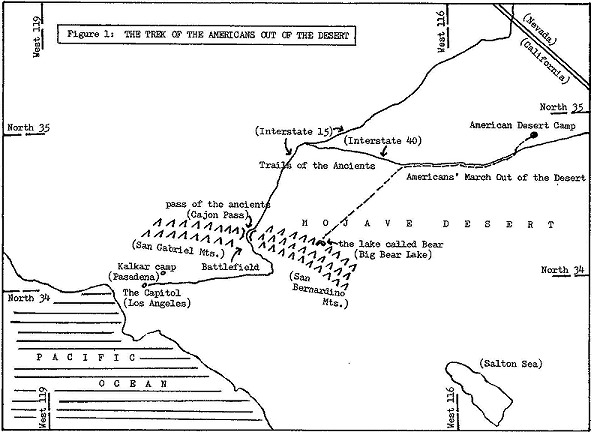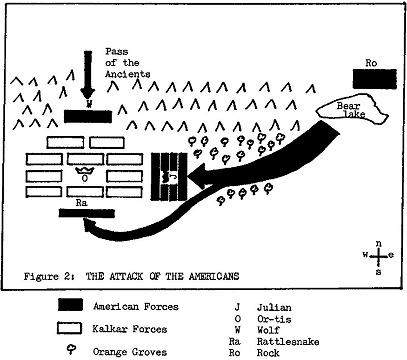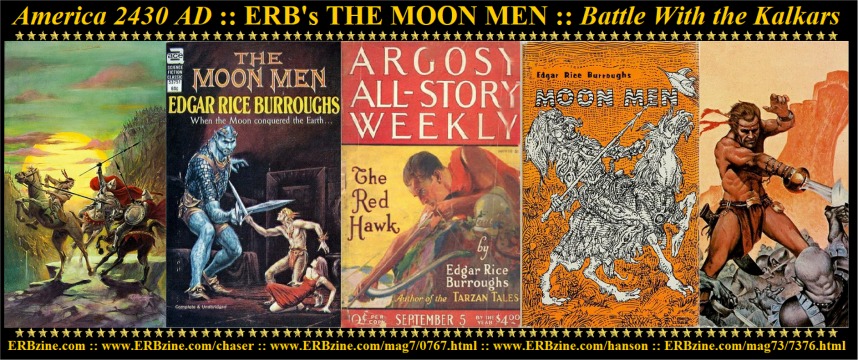
The Battle of the Pass of the Ancients
by Alan Hanson
 There is something sublime about walking the ground of an
old battlefield. This is not so of the battles of our century, which have
been fought for the most part from a distance with rifles and artillery.
They are too impersonal. But in the battles of hundreds of years ago, when
antagonists carried the battle ax, the broadsword, or the claymore into
hand-to-hand combat, a soldier had to look into the eyes of the man he
killed or who killed him. Battles seem such wasteful things, but there
is inspiration in knowing that men from time to time held convictions so
strong that they were willing to come by the thousands and die that their
beliefs might live.
There is something sublime about walking the ground of an
old battlefield. This is not so of the battles of our century, which have
been fought for the most part from a distance with rifles and artillery.
They are too impersonal. But in the battles of hundreds of years ago, when
antagonists carried the battle ax, the broadsword, or the claymore into
hand-to-hand combat, a soldier had to look into the eyes of the man he
killed or who killed him. Battles seem such wasteful things, but there
is inspiration in knowing that men from time to time held convictions so
strong that they were willing to come by the thousands and die that their
beliefs might live.
On what field did Americans fight their greatest battle?
Historians might debate the significance of the struggles at such places
as Yorktown, Gettysburg, Chateau-Thierry, and Iwo Jima. Surely, though,
the greatest battle of all on the North American continent has yet to be
fought. It will be contested an April day in the year 2430 among the orange
groves at the western base of Cajon Pass in what we now call California.
(Note: The date given in the magazine version of The Red Hawk
was chosen over the date of 2434 given in the book version of The
Moon Maid.)
The only known account of this battle, which we will call
the Battle of the Pass of the Ancients, comes from the memoirs of
Julian 20th, the commander of the American forces on the field that day.
His account comes back to us, apparently, through an earlier pre-incarnation
of himself. Though the battle will be fought in the future, to make it
easier understand in the present day, the events surrounding the battle
will be recounted in the past tense.
A Racial Conflict
The Battle of the Pass of the Ancients
brought to an end 384 years of racial strife between the descendants of
the moon men, who invaded and conquered the earth in 2050, and the descendants
of the native Americans who were subjugated at that time. At the same time,
the battle brought to a close a feud between the families of Julian and
Or-tis that began in 2050 when Julian 5th and Orthis both died during the
decisive air battle of the moon invasion.
The moon men, or Kalkars, thoroughly subdued the
American people until Julian 9th led the first uprising against their authority
in 2122 in present-day Illinois. Over the next 300 years, the Americans
slowly forced the Kalkars westward and eastward across the continent. The
Kalkars’ ultimate fate on the eastern shore is unknown, but we do know
that in about the year 2300, Julian 15th drove the Kalkars across the Mojave
Desert, over the mountains and into the central valley of California. There,
with only narrow mountain passes to defend, the Kalkars held. At least
20 times in the next 100 years, the Americans went into the valley in force,
only to be driven back.
The Trek of the Americans
Out of the Desert
The Americans’ final assault on the
Kalkars awaited only a strong and imaginative leader. He was to be Julian
20th, who came to power in August 2429 at the age of 20. In January 2430,
Julian announced to his people that, following the spring rains, they would
move out of the desert to settle in the Kalkar valley. By April the thousand
clans that owed allegiance to the house of Julian had gathered at Julian’s
camp in the eastern Mojave Desert. Fully 50,000 people, half of them warriors,
started the trek, following “the trail the ancients used,” probably
remnants of Interstate 40 (see map 1). Julian, reasoning
that success depended on hiding their position and strength from the enemy
as long as possible, took his people off the trail after four days. To
hide their advance, he led them on a difficult march across a stretch of
desert and up into the mountains to “a like called Bear” by the
American’ slaves (Big Bear Lake in the San Bernardino Mountains). This
placed their camp about 25 miles to the east of the pass of the ancients
(Cajon Pass), where the Americans had attempted to enter the valley for
a hundred years and where the Kalkars had come to expect them.

Click for full size
The American Battle Plan
Being greatly outnumbered, Julian knew
he needed to draw the Kalkars into a major battle. A decisive victory would
leave the Kalkar military in confusion long enough for the Americans to
gain a secure base in the valley for further military operations.
Julian’s strategy was to draw the enemy to a battlefield
of his choosing, while hiding the strength and location of his own force
from the Kalkars. He did this by keeping his main force at the Bear lake
camp and sending The Wolf with 1,000 warriors to the pass of the ancients
to stage three days of false advances. Julian’s hopes of luring a substantial
Kalkar force were realized. American scouts reported Kalkars filling every
trail from the south and west heading for the pass. Just as important,
no enemy scouts spotted the large American camp at Bear lake.
Once Julian had drawn the Kalkars into the field, he relied
on the maneuverability of his warriors and a surprise attack to win the
battle (see Map 2). On the evening of the third day of The
Wolf’s false attacks, Julian led 20,000 warriors slowly down the mountain
trails and into the orange groves in the foothills below Bear lake. Mounting
their war horses for the first time in two weeks, this force turned northwest
for a 25-mile ride to the Kalkar camp. About 10 miles from the enemy’s
position, The Rattlesnake was dispatched in a more westerly direction with
5,000 warriors to attack the Kalkars’ rear. Julian moved on with the main
force, intending to attack on the flank while placing himself between the
main body of Kalkars and their supplies and reinforcements.
Julian’s plan called for a surprise attack while the enemy
slept. The Rattlesnake’s orders were to attack as soon as his force was
in position, the sound of the assault being the signal for the forces of
Julian and The Wolf to move in. Advancing his force to within a mile of
the nearest Kalkar camp fires, Julian anxiously awaited the signal.

Click for full size
The Armies
Of the force of 25,000 warriors that
the Americans brought out of the desert, 4,000 did not engage in the fight.
They had been left under the command of The Rock to guard the Bear lake
camp. All of the 21,000 who did fight were mounted. The exact number of
the Kalkar force is unknown, although there is no doubt it greatly outnumbered
the Americans. Julian refers to it as “a great horde.” Most of the
Kalkars probably rode mounts to their camp, but many fought on their feet
as the American surprise attack prevented them from finding their horses.
Centuries of Kalkar rule resulted in a decline of scientific
knowledge to the point that the use of firearms was unknown, and they were
not used by either side during the battle. One thousand American warriors
were armed with bow and arrows. Other weapons carried by Americans included
lance double-edged swords and knives. The Kalkars used the same weapons,
only heavier. They also wore iron bonnets and vests of iron on their chests.
Choosing not to encumber themselves with the weight of the metal, the Americans
carried only a light shield on the left forearm for defense.
The Battlefield
When Julian led his attacking force
to the crest of a low ridge during his night advance, he got his first
glimpse of the field on which the battle would be fought. Before him stretched
a broad valley bathed in moonlight. Orange groves in the near foreground
would cover his final advance, and beyond to the northwest was a great
open area dotted with dying campfires. The wide-open ground suited the
agile Americans over the slow Kalkars, who, with their heavy weapons, would
be more effective in a more enclosed arena.
The Action
There was a crisis for the Americans
even before the battle started. For some reason never explained, The Rattlesnake
was delayed in reaching the rear of the Kalkars. If The Rattlesnake had
not been in position by the time the Kalkars began waking, Julian would
have been forced to attack from two sides only, giving the Kalkars an avenue
to retreat and reorganize. However, just at dawn the war drums of The Rattlesnake
sounded and Julian’s forces charged the camp.
Julian deployed his force along a two-mile front in the
groves, with the 1,000 archers in front and line after line of lancers
and swordsmen behind. As they charged, the bowmen fired at the confused
Kalkars. Those who escaped the arrows were trampled beneath the horses
of the lancers behind.
The tents of Or-tis were seen ahead, and there quickly
developed the battle center. The American advance was slowed as the warriors
crowded in upon one another, and some Kalkars were able to mount behind
the front lines. The battle soon became a matter of hand-to-hand combat,
as the two sides drove each other to-and-fro in a series of broken engagements.
The American strategy at this point turned to fighting
in a circular motion around the main body of Kalkars in an effort to close
off escape routes. By the end of the day, Julian reported he was back south
of Or-tis’ position, having fought all the way around it during the day’s
fighting.
Lulls in the conflict occurred as both sides fought to
the limit of endurance. The superb physical condition of the Americans
proved an advantage. Julian told of hundreds of Kalkars dropping dead in
the heat of the day, while only the very young and the very old among the
Americans succumbed to fatigue.
Fighting halted at nightfall when friend and foe became
indistinguishable. Julian, in keeping with his ultimate goal of exterminating
the Kalkars, was unwilling even then to give the Kalkars the opportunity
to retire from the field. The clans were formed in a solid ring around
the Kalkar position and ordered to hold their position during the night
and be ready for battle again at first light. It should be noted here the
extreme fatigue the Americans must have been feeling. They had just finished
an 18-hour battle and had not slept in 36 hours.
The Retreat of the Kalkars
If the Americans had hoped to get some
rest on the battlefield that night, they were denied it by a daring and
desperate Kalkar escape march. Toward dawn, Julian reported, the entire
body of Kalkars rode out in what he likened to “a great slow moving
river” toward the south down the broadening valley. In the middle of
the retreat must have been Or-tis, who never was seen during the battle.
The Americans cut the Kalkars down by the thousands from the sides and
front, but the sheer numbers of the enemy and the fatigue of the Americans
allowed thousands more Kalkars to leave the field and flee toward The Capitol.
Casualties
Julian did not provide casualty figures
for either side. However, several days after the battle, he told Bethelda
that “thousands” of Americans died. The Kalkar dead surely were
much higher. During the battle, Julian describes corpses of warriors and
horses so thick that living horses could barely climb over them. Sometimes
bodies were stacked so high that they formed barriers that had to be gone
around. During the retreat alone, thousands and thousands of Kalkars were
hacked down from the edges of the retreating mass. The following day, of
the Kalkar dead, Julian could only say that, “their losses must have
been tremendous I was sure.”
If Julian would not hazard a guess, let us do so. From
the account of the battle, let us place the American dead at 3,000 and
the Kalkar losses at four times that.
The Aftermath
The Kalkars had an opportunity to salvage
a peace with the Americans despite their crushing defeat when they captured
Julian himself during their retreat. However, it was a reflection of the
strength of the American leadership that their assault on The Capitol went
ahead without their top commander. Unable to bargain with Julian, Or-tis
ordered him executed, but the American eventually escaped to rejoin his
people.
As a captive in the Kalkar camp the day after the battle,
Julian judged from overhearing conversations that the defeat of the Kalkars
was complete, and they were fleeing toward the coast. In fact, he would
confide, “This first victory has been greater than I had dared hope.”
The Americans followed up the victory with an immediate assault on the
Capitol.
It was to take two more years of hard fighting to drive
the last of the Kalkars into the sea, but the fate of the two races had
been effectively decided in that epic battle on a fateful April day among
the orange blossoms below the pass of the ancients.
—the end—



![]()
 .
. .
.
![]()
![]()
![]()
![]()
![]()
![]()

![]()